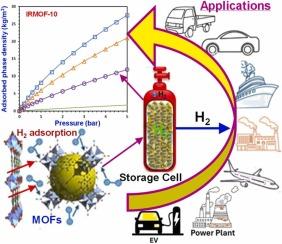Highly efficient hydrogen storage on porous materials under cryo-adsorption conditions
引用次数: 0
Abstract
Hydrogen has emerged as a promising clean energy carrier; however, its efficient storage remains a significant challenge. Current storage methods often fail to meet the desired volumetric and gravimetric targets owing to issues such as boil-off, hydrogen leakage, heat transfer losses, and material quality limitations. Enhancing hydrogen density in porous materials through adsorption offers a potential solution, as hydrogen interactions with materials such as metal-organic frameworks (MOFs) or carbon-based adsorbents are stronger than hydrogen-hydrogen interactions in liquid hydrogen, ammonia, or liquid organic hydrogen carriers. This study investigated the hydrogen uptake of various MOFs, including MIL-101, MOF-177, MOF-5, UiO-66(Zr), DUT-117 (Cu), and DUT-117, and activated carbon (type Maxsorb-III). Experiments were conducted under cryogenic conditions (77 K, 87 K, and 112 K) and pressures ranging from 0.1 to 5 bar. The results revealed that MOF-177 and IRMOF-10 exhibited promising hydrogen storage capacities, achieving gravimetric uptakes of 4.09 wt% and 4.55 wt%, respectively, and volumetric uptakes of 0.014 kg/L and 0.01 kg/L at 5 bar and 77 K. Using experimentally confirmed isotherms, kinetics, and thermodynamic frameworks of MOFs–H2 systems, this study analyzed the dynamic behavior of hydrogen storage across pressures (1–5 bar) and temperatures (77 K–298 K). These findings demonstrate that the hydrogen densities in porous materials under cryogenic conditions are 10 times higher than those in the gaseous phase. These insights are critical for designing and optimizing adsorption-based hydrogen storage systems, paving the way for more efficient and scalable hydrogen energy solutions.

低温吸附条件下多孔材料的高效储氢
氢已经成为一种有前途的清洁能源载体;然而,它的高效存储仍然是一个重大挑战。由于蒸发、氢气泄漏、传热损失和材料质量限制等问题,目前的储存方法往往不能满足所需的体积和重量目标。通过吸附提高多孔材料中的氢密度提供了一种潜在的解决方案,因为氢与金属有机框架(MOFs)或碳基吸附剂等材料的相互作用强于液氢、氨或液态有机氢载体中的氢氢相互作用。本研究考察了MIL-101、MOF-177、MOF-5、UiO-66(Zr)、DUT-117 (Cu)和DUT-117以及活性炭(Maxsorb-III型)的吸氢情况。实验在低温条件下进行(77 K, 87 K和112 K),压力范围为0.1至5 bar。结果表明,MOF-177和IRMOF-10具有良好的储氢能力,在5 bar和77 K条件下,其吸氢量分别为4.09 wt%和4.55 wt%,体积吸氢量分别为0.014 kg/L和0.01 kg/L。利用实验证实的MOFs-H2体系的等温线、动力学和热力学框架,本研究分析了压力(1-5 bar)和温度(77 K - 298 K)下储氢的动态行为。这些发现表明,低温条件下多孔材料中的氢密度比气相高10倍。这些见解对于设计和优化基于吸附的储氢系统至关重要,为更高效、可扩展的氢能解决方案铺平了道路。
本文章由计算机程序翻译,如有差异,请以英文原文为准。
求助全文
约1分钟内获得全文
求助全文

 求助内容:
求助内容: 应助结果提醒方式:
应助结果提醒方式:


